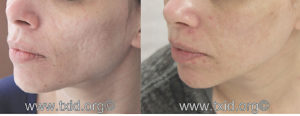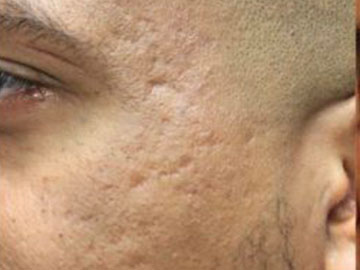Treatment of Acne Scar in San Antonio Boerne Acne Clinics by iCLear ™ , an Effective Light System for Acne Scars
Acne Scars Are Treated Successfully at Texas Institute of Dermatology in San Antonio and Boerne.
Our acne scar clinic in San Antonio and Boerne are one of the top Acne Scar Laser treatment centers in the country staffed by fully trained dermatologists, specialized in non-invasive (laser light treatment) and minimally invasive (PRP, Subcision, Punch) of Acne Scars.
At Texas Institute of Dermatology, San Antonio Boerne Clinic, we offer the latest state-of-the art lasers for Acne and Acne Scar treatment. Our Dermatologists at TXID Acne San Antonio and Boerne Clinics offer state-of-the art lasers and light devices such as LED for the treatment of Acne and Acne Scarring. Laser, PRP technology and light treatments are offered at our San Antonio and Boerne Clinics not only to treat acne and acne scarring but also to target the pilosebaceous units (the root cause of acne) and thereby to reduce the redness and inflammation seen in Acne.
In order to properly treat acne scars, new collagen should be produced to fill the large defects and upper layers of the skin should be replaced by a new skin. This method does stimulate maximum collagen production from underneath, thereby allowing the skin to build a fresher, clearer surface.
The research team at our Acne laser treatment center in San Antonio has recently developed iClear™️, a revolutionary light-based system to successfully treat Acne scars by combining several cutting edge technology. iClear™️ has changed many patients lives by successfully filling the scars with collagen, something that could rarely happen with other available treatments such as topical creams or lotions.iClear Laser for acne Scar Before After

The iClear ™ system is best suited to promote this natural process. The complete iClear™️ system reduces potential complications by ensuring a precise depth of abrasion. Deeper scars may also require subcision or punch grafts 4-6 weeks prior to laser treatment in order to achieve the look you desire. Due to recent advances in technology, fillers can also be used to bolster scars. Often, acne scars may be preventable if acne treatment is started early and patients do not touch the pimples.
What Causes Acne Scarring?
Acne scars occur when damage is done to the skin’s tissue that cannot be repaired by the body. Often, acne scarring is a direct result of “picking” or “squeezing” a blemish. Acne scaring can be permanent and may involve both pigmentation and texture changes. There are three types of acne scars:


Treatment of Acne Scars
In the past, acne scarring has been considered to be permanent. But, with the latest research and newly developed technology, noticeable improvement can be seen even in some of the most severe cases of acne scaring. A combination of acne treatments may be required to achieve desired results. Treatment of acne scarring is usually considered an elective cosmetic procedure, and in most cases, it will not be covered by your insurance. Prior to treatment the acne needs to be under control. and the skin needs to be clear. Otherwise, new scars can form and the procedures will be wasted.
The most effective treatment is a combination treatment. According to Dr. Ghohestani, acne scars cannot be treated with topical creams alone. Each individual’s scar requires a unique approach, said Dr. Ghohestani, former chief of Dermatology at University of Texas. Effective treatment options available for acne scaring include (all treatment options are offered at our San Antonio Clinic) :


Dermabrasion :
We usually recommend having a microdermabrasion before any acne laser treatment. The Micro-dermasbrasion, in addition to opening the pores, will remove the corneal layer and comedones along with the superficial layer of the skin therefore, increasing the efficiency of the laser treatment.Dermabrasion uses a small, titanium tip similar to fine-grained sand paper to mechanically resurface the skin.
There are two dermabrasion techniques available: Superficial Abrasion and Deep Abrasion. Superficial dermabrasion is less aggressive and removes portions of the epidermis (top layer of skin) while deep dermabrasion removes all of the epidermis and portions of the dermis (deeper layer of skin). Deep methods are effective, especially in the case of acne scarring, but generally require weeks of healing time and carry a higher risk of complications. Improvements continue for months after the procedure as collagen remodels underneath the skin.
Not everyone is a good candidate for dermabrasion. Those with active acne, infections, and other scarring skin conditions may need treatment before undergoing dermabrasion. Deep ice pick scars do not typically improve significantly with dermabrasion. Dermabrasion may not be recommended for those with darker skin types because of the risk of hyperpigmentation, or darkening of the skin. Dr. Ghohestani can meet with you, examine your skin, and help you decide whether dermabrasion is right for you.
Dermasanding and Microneedling:
This technique consist of abrading the skin with silicone carbide sandpaper or microneedles. Generally, dermasanding and microneedling is not used as a stand-alone treatment. Many treatment plans will also include chemical peels, CO2 lasers, and microdermabrasion.
iClear™️, One of the Best Available Options for Acne Laser Treatment :
iClear™️ is one of the most comprehensive treatment for acne scars. iClear™️ is exclusively offered at our San Antonio Acne Clinic. iClear ™️ stimulates new collagen formation; you will appreciate a significant decrease in depth and appearance of Acne Scars after treatment. Our Acne Scar treatment (depending on your skin type) may includeQ-Switched Nd:Yag, Spectra laser with or without Carbon Peel, advanced radiofrequency, AFT, and fractional Co2 resurfacing laser. Sometimes, Dr. Ghohestani may suggest to add Platelet Rich Plasma (PRP) to increase collagen stimulation.
iClear ™️ is a combination therapy specifically designed for Acne Scarring. Before development of iClear ™️ , most dermatologists offered only a Co2 laser resurfacing. With iClear ™️ your acne scars significantly improve after receiving 12 different techniques in 3 sessions within 60 days.
Laser Skin Resurfacing :
Treatment of Acne Scar in San Antonio by Laser iClear Laser skin resurfacing is an ablative procedure, meaning the laser removes the outer layers of the skin. Both the CO2 and the Erb Yag lasers are designed to penetrate through the epidermis and superficial dermis and are highly effective in the treatment of acne scarring. Ablative techniques are aggressive and therefore, more effective, but they do require several days for recovery. Subcision:
This process helps to release scar tissue common in atrophic scars. After administering a local anesthetic, the doctor will insert a needle under the skin and gently break down the scar tissue.
Subcision:
This process helps to release scar tissue common in atrophic scars. After administering a local anesthetic, the doctor will insert a needle under the skin and gently break down the scar tissue.
Fillers:
Dermal fillers are becoming increasingly popular. These substances are used to add volume to the skin. Depending on the nature of the scars, dermal fillers can be used as a sole or combination treatment. Because dermal fillers are organically-based, their effect will eventually wear off. Further injections will be necessary in order to maintain desired results.
Punch excision and Grafting :
Punch excision and grafting is used for deep ice pick scars that cannot be effectively treated any other way. This process consists of removing the scar using a punch (small cookie-cutter looking device) and then suturing the edges of the scar together. In essence, the larger scar is replaced with a smaller scar that can later be treated with creams, dermabrasion, and/or laser resurfacing. Another option is skin grafting, which consists of excising (cutting out) the scar and grafting in a piece of skin (usually taken from behind the ear). After healing, the graft can then be blended into the surrounding skin using dermabrasion or laser treatments.
Microneedling:
Microneedling is a simple procedure involves inserting a needle into the scars usually offered by Med Spa or those who are not qualified to use pricey advanced laser technology. The repetitive movements of a needle may contribute to tissue remodeling as a result of micro-injury. However, the amount of collagen production, if any has not been documented according to Dr. Ghohestani, who has years of experience as a dermatologist and research scientist.
Chemical Peels :
Chemical peels (or chemical resurfacing) is used to improve the appearance of the skin, including acne scars. Specific chemical are used, such as glycolic acid, Obagi Blue peel, trichloroacetic acid (TCA), and salicylic acid to produce differing degrees of controlled injury to the skin. The natural healing process of the body then takes over to produce new, healthier looking skin. Medium depth and deep peels produce injury within the dermis and can improve the appearance of atrophic acne scars. The deeper peels are more effective but carry more risks such as infection, scarring, and discoloration, especially for patients with dark skin. Chemical peels nowadays are being replaced by various laser procedures.
Steroid Injections :
In rare cases hypertrophic and keloid scars may be more difficult to treat than other acne scars. This kind of scarring is more common on the chest and back and is more often pronounced in African Americans. For reasons currently unknown to us, hypertrophic scars can and often do recur after treatment. Therefore, a careful treatment plan is often necessary to maximize the potential for desired results.
Although acne scarring is permanent, there are treatment options. Because no treatment is 100% effective, the best result is scar improvement, not perfect skin. Different scarring requires different treatment. These treatments can be expensive and may not be covered by insurance. According to Dr. Ghohestani, acne scars cannot be treated with topical creams. The most effective treatments are surgical, such as fractional CO2 laser treatment.

Our mission is to serve as a leading center for understanding and treating Acne Scars in South Texas through excellence in patient care, research, and education. We want you to feel that you have been treated with the comfort, privacy, safety, and satisfaction that you deserve. This is why all of our procedures for treatment of Acne and acne Scars are performed or supervised by our renowned dermatologist, Dr. Reza Ghohestani.
His experience, combined with the latest technology and caring staff, is why the Texas Institute of Dermatology is consistently ranked among the top dermatology centers for treatment of Acne Scars in San Antonio and Boerne areas based on peer reviewed satisfaction surveys. We currently serve communities throughout Bexar and Kendall counties, including San Antonio, Boerne, Leon Springs, Fair Oaks Rank, Canyon Lake City, etc. Many of our patients also come from San Marcos, New Braunfels, Kerrville, Austin, Wimberly, and Corpus Christi.

For an appointment, call 210-698-6777
Stone Oak Clinic: 238 North Loop 1604 E, Suite 208, San Antonio , TX 78232
Leon Springs CLinic: 24165 W IH-10, Suite 102, San Antonio, TX 78257
